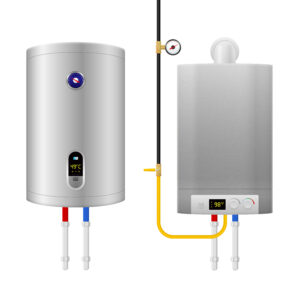|
Getting your Trinity Audio player ready...
|
PEX pipe is rapidly becoming the go-to choice in modern plumbing systems—and for good reason. Known for its flexibility, durability, and affordability, PEX has replaced traditional piping materials in many residential and commercial projects.
But what is PEX pipe exactly? Let’s explore everything you need to know about this game-changing plumbing solution and why it has revolutionized how we think about pipes.
Understanding What Is PEX Pipe
PEX stands for “cross-linked polyethylene,” a type of plastic that has been chemically modified to improve its performance. The cross-linking process makes the material more resistant to high temperatures, chemicals, and stress. This innovation has made PEX pipe a highly versatile alternative to copper, PVC, and galvanized steel pipes.
How PEX Is Manufactured
PEX is created by introducing chemical cross-links between polyethylene polymer chains. There are three main methods used in manufacturing: PEX-a, PEX-b, and PEX-c. Each type has unique properties, with PEX-a being the most flexible and kink-resistant, while PEX-b and PEX-c offer excellent strength and lower costs.
Types of PEX Pipe
- PEX-A: Most flexible, ideal for remodeling and tight spaces.
- PEX-B: More affordable, slightly stiffer, but widely used in new construction.
- PEX-C: Made using radiation, good durability, but less common.
PEX Pipe in Plumbing: Why It’s Popular
The rise of PEX pipe in the plumbing industry stems from its multiple benefits. Not only does it make installation easier and quicker, but it also offers long-lasting performance, making it a plumber’s best friend.
Why is PEX piping considered easier and more efficient to install than traditional piping?
PEX piping can bend around corners, reducing the need for fittings and connections. This makes the installation process faster and requires fewer materials. Plus, it’s lightweight—so even a solo installer can manage large projects without assistance.
How does PEX piping help prevent pipe bursts in freezing temperatures?
PEX pipe’s flexibility allows it to expand slightly when frozen, reducing the risk of bursting. That’s a massive advantage in colder climates where copper pipes are prone to freezing and cracking.
Is PEX piping more cost-effective than copper for home plumbing?
When comparing PEX to copper, the cost savings are significant. Not only is the material cheaper, but the quicker installation times mean lower labor costs, making it a cost-effective solution for homeowners and builders alike.
How does PEX piping compare to copper, PVC, and CPVC?
Let’s face it—plumbing choices can be overwhelming. So how does PEX pipe stack up against other popular materials like copper, PVC, or CPVC?
| Feature | PEX Pipe | Copper Pipe | PVC/CPVC Pipe |
|---|---|---|---|
| Flexibility | High | Low | Moderate |
| Cost | Low | High | Moderate |
| Freeze Resistance | Excellent | Poor | Poor |
| Installation Ease | Easy | Difficult | Moderate |
| Durability | High | Very High | Moderate |
| Chemical Resistance | Excellent | Moderate | Excellent |
From the table, it’s easy to see why PEX is a popular choice—it combines affordability, performance, and ease of use in one versatile package.
What Are The Common Applications Of PEX Piping Beyond Residential Plumbing?
PEX pipe isn’t just for home plumbing. Its uses span various sectors due to its reliability and cost-efficiency.
Why Is PEX Piping Ideal For Residential Water Supply Systems?
PEX is commonly used for hot and cold water distribution systems in homes. It can run long distances without needing many joints, reducing the chances of leaks.
How Is PEX Piping Used In Radiant Floor Heating Systems?
Thanks to its ability to withstand high temperatures and flexibility, PEX is ideal for underfloor heating systems. It provides even heat distribution and reduces energy consumption.
Can PEX Piping Be Used In Commercial And Industrial Plumbing Projects?
Larger-scale plumbing systems also benefit from PEX, especially in retrofitting old buildings or extending water systems where navigating existing infrastructure is tricky.
What Types of Fittings And Connections Are Used With PEX Piping to Ensure a leak-free system?
While PEX pipe itself is flexible and easy to handle, its fittings are what ensure a leak-free system. There are several options available:
How Do Crimp Ring Fittings Work For Connecting PEX Pipes?
Crimp ring fittings are one of the most commonly used methods for connecting PEX pipes. They involve sliding a copper ring over the pipe, then inserting the fitting and compressing the ring using a crimping tool. This creates a tight and leak-free seal when done correctly.
What Is The Process For Installing Clamp (Cinch) Rings On PEX Pipes?
Clamp rings use stainless steel cinch clamps instead of copper. After placing the clamp over the PEX pipe and fitting, a special cinch tool tightens the clamp until it securely holds the pipe. It’s a cost-effective and reliable method with a slightly easier installation process.
How Do Push-to-connect fittings work for PEX pipes, and why are they ideal for DIY projects?
These fittings require no special tools, making them perfect for quick fixes and DIY projects. Simply push the PEX pipe into the fitting until it clicks and locks in place. It’s fast, user-friendly, and ideal for tight spaces or emergency repairs.
How Do Expansion Fittings Work With PEX Pipes?
Expansion fittings involve expanding the PEX pipe using a dedicated expansion tool, then inserting the fitting before the pipe contracts. As the pipe shrinks back to its original shape, it forms a secure and pressure-resistant connection. This method offers superior flow capacity and flexibility.
Each method has its advantages, and the choice depends on the project’s needs, budget, and tools available.
PEX Pipe Color Coding and Identification
This color-coding system simplifies installation and maintenance, allowing plumbers to trace lines with ease. PEX pipe comes in different colors for easy identification:
PEX Pipe Red In Color
Red PEX pipe is used specifically for hot water supply lines in residential and commercial plumbing. Its color coding makes it easy to distinguish and trace hot water lines during installation and maintenance. This reduces confusion and speeds up repair or upgrade processes.
PEX Pipe Blue In Color
Blue PEX pipe designates cold water supply lines, providing a clear visual indicator during plumbing layouts. It ensures easy identification, especially when multiple lines are installed close together. Like red, the blue color doesn’t affect performance—just improves organization.
PEX Pipe White/Clear In Color
White or clear PEX is versatile and can be used for both hot and cold water applications. It’s ideal for general-purpose plumbing where color coding isn’t a concern or in tight spaces where flexibility is more important. Many professionals prefer white PEX for its neutrality and multipurpose use.
Is PEX Pipe Safe For Drinking Water, And What Certifications Does It have?
PEX pipe is approved by major plumbing codes in the U.S. and globally. It meets NSF/ANSI standards for potable water and is BPA-free, making it a safe choice for drinking water systems.
PEX Pipe Longevity and Lifespan
PEX pipe boasts an impressive lifespan—typically over 50 years under normal conditions. Its resistance to scale, corrosion, and pinhole leaks makes it a long-term investment for any property.
Maintenance and Repair
Although durable, PEX pipe can occasionally require repairs. The good news? Fixes are simple and involve replacing a section using basic tools and fittings. Unlike copper, no soldering is needed, which makes DIY repairs feasible.
Common Myths About PEX Pipe
Let’s bust a few myths:
PEX can’t handle high temperatures
This is a common misconception—PEX can safely handle water temperatures up to 200°F. It’s widely used in hot water lines and radiant heating systems because of this heat resistance. Its thermal flexibility makes it superior to many traditional materials.
It’s not durable
In reality, PEX is extremely durable and long-lasting under normal conditions. It resists scale build-up, corrosion, and chlorine, which often damage metal pipes. Its ability to expand under pressure also helps prevent cracking and bursting.
Rodents chew through PEX
While rodents can chew through PEX, they can also damage copper and other materials. This issue typically arises in poorly insulated or unfinished spaces like basements and attics. Using protective coverings and proper installation techniques greatly reduces the risk.
Environmental Impact of PEX Pipe
PEX pipe is a more sustainable option compared to metal pipes. Its production requires less energy, and its lighter weight means reduced fuel use during transportation. Plus, it’s recyclable, which minimizes environmental impact.
Is PEX Pipe Right for Your Project?
The short answer: most likely, yes. Whether you’re building a new home, remodeling, or upgrading old plumbing systems, PEX offers a range of benefits that make it ideal for various applications.
PEX Pipe in the Future of Plumbing
With ongoing innovations in plastic technology, PEX pipe is set to remain a cornerstone of modern plumbing for decades. Its adoption is growing worldwide due to its unmatched combination of flexibility, strength, and cost-effectiveness.
People Also Asked Questions (PEX FAQs)
What is PEX pipe used for?
PEX pipe is primarily used for water supply lines, radiant floor heating, and in some cases, fire sprinkler systems.
How long does PEX pipe last?
PEX pipe can last over 50 years if installed correctly and under normal usage conditions.
Is PEX pipe better than copper?
For many applications, yes. PEX is cheaper, easier to install, and more resistant to freezing than copper.
Can PEX pipe be used outdoors?
While PEX can be used outdoors, it must be protected from direct sunlight as UV rays can degrade the material over time.
Is PEX pipe safe for drinking water?
Yes, PEX is BPA-free and certified safe for potable water systems under NSF/ANSI standards.
Does PEX pipe burst like copper in winter?
No. PEX is flexible and can expand slightly, reducing the chance of bursting in freezing temperatures.



